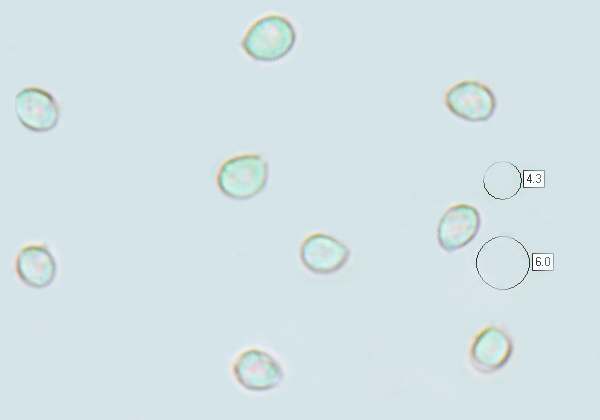Grifola frondosa (Dicks.) Gray - Hen of the Woods
Phylum: Basidiomycota - Class: Agaricomycetes - Order: Polyporales - Family: Meripilaceae
Distribution - Taxonomic History - Etymology - Identification - Culinary Notes - Reference Sources
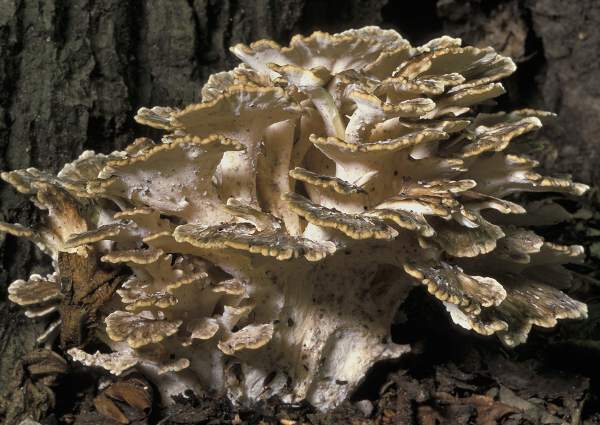
Commonly referred to as Hen of the Woods, the fruitbody of Grifola frondosa is relatively short-lived compared with most polypores. It is usually found at the base of an oak tree.
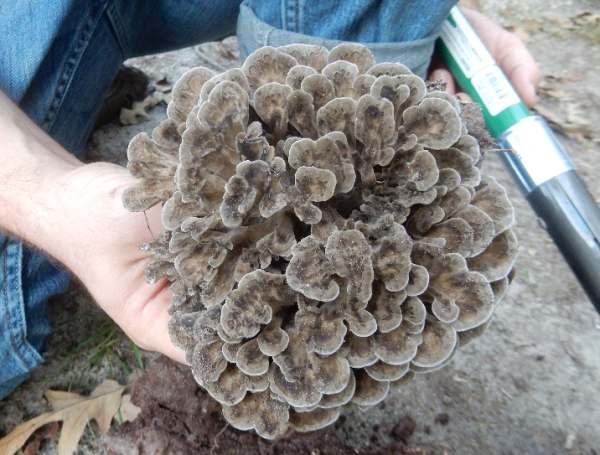
Above: This fine specimen is from Virginia, USA.
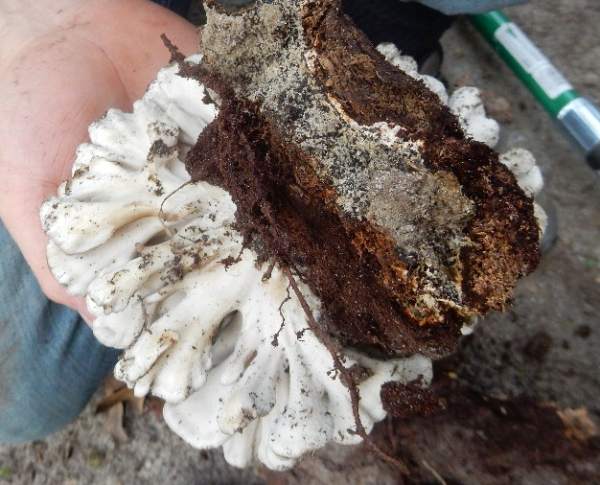
The picture above shows the broad connection of a Hen of the Woods fruitbody to a root of its host tree.
This fungus attacks living trees and causes a white rot, and it smells unpleasantly sickly when it is decaying.
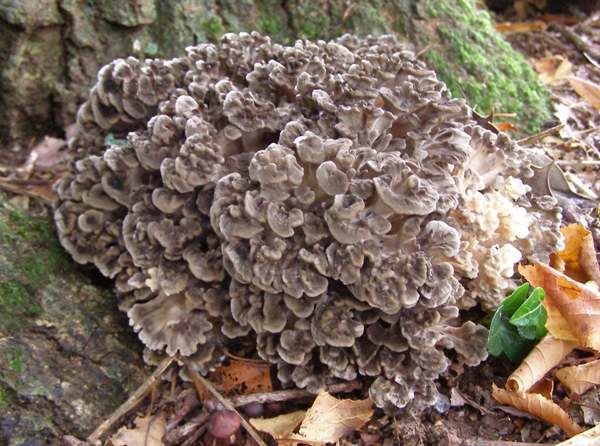
Distribution
Uncommon and rather localised in Britain and Ireland, Hen of the Woods is also found in mainland Europe and in North America.
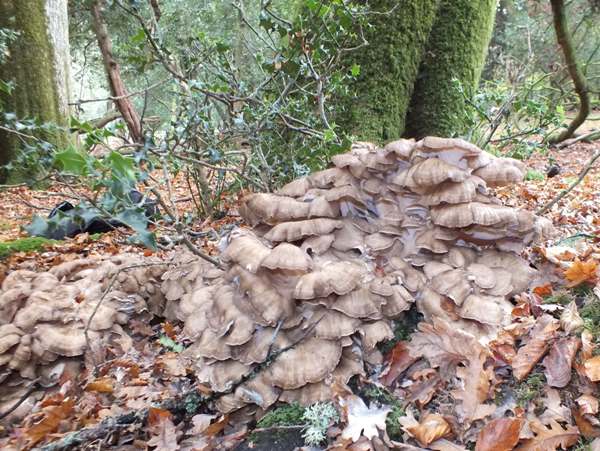
Taxonomic history
Scottish mycologist James J Dickson (1738 - 1822) described this polypore in 1785, establishing its basionym when he gave it the scientific name Boletus frondosus. It was another Briton, Samuel Frederick Gray (1766 - 1828), who in 1821 transferred this species to the genus Grifola, establishing its currently-accepted scientific name as Grifola frondosa.
It's hardly surprising, in view of its large size and high culinary value, that over the past two and a quarter centuries many other highly-respected authorities have described and given scientific names to Hen of the Woods, and so among its many synonyms are Boletus frondosus Dicks., Boletus elegans Bolton, Polyporus frondosus (Dicks.) Fr., Polyporus intybaceus Fr., Grifola frondosa f. intybacea (Fr.) Pilát, and Grifola intybacea (Fr.) Imazeki.
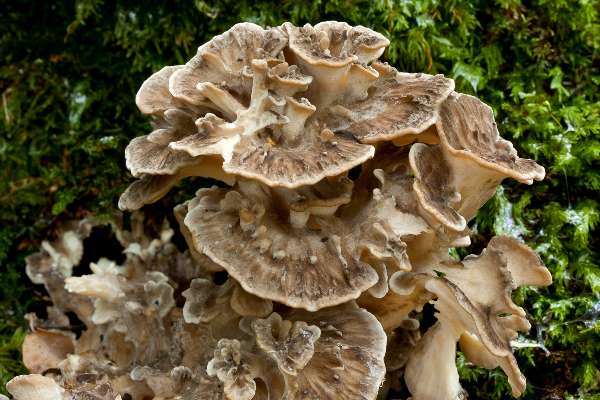
Etymology
The specific epithet frondosa means having fronds (a leaf-like form).
Identification guide
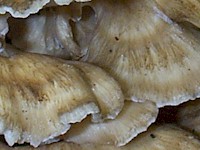 |
DescriptionIn circular tiers from a common branching stem, the tongue-like fronds of this soft polypore form a cauliflower-like rosette 20 to 50cm across. Individual fronds are 4 to 10cm across and 5 to 10mm thick, and they vary from tan to olive, grey or cream in undulating concentric zones. Very occasionally Grifola frondosa occurs in an almost pure white form. |
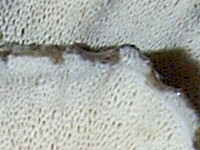 |
Tubes and PoresThe white tubes are 2 to 3mm deep and usually rounded; they terminate in pale cream pores that are decurrent to the stem. |
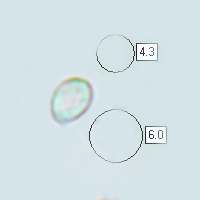 |
SporesBroadly ellipsoidal, smooth, 5-7 x 3.5-5μm; inamyloid. Spore printWhite. |
Odour/taste |
Pleasant sweet odour when young; less so when decaying. The taste of older specimens can be quite acrid. |
Habitat & Ecological role |
At the bases of oak trees and occasionally other hardwoods. |
Season |
Summer and autumn. |
Similar species |
Polyporus umbellatus (common synonym Grifola umbellata) is much rarer in Britain and Ireland, but in many respects it is a quite similar species with branched stems more or less centrally attached to terminal caps that are centrally depressed. Grifola frondosa could possibly be confused with the much paler Wood Cauliflower, Sparasis crispa, but that grows only at the bases of conifers, and most frequently Scots pines. Meripilus giganteus often forms rosettes at tree bases or from underground roots, but its fronds are much thicker and its main host is Beech. |
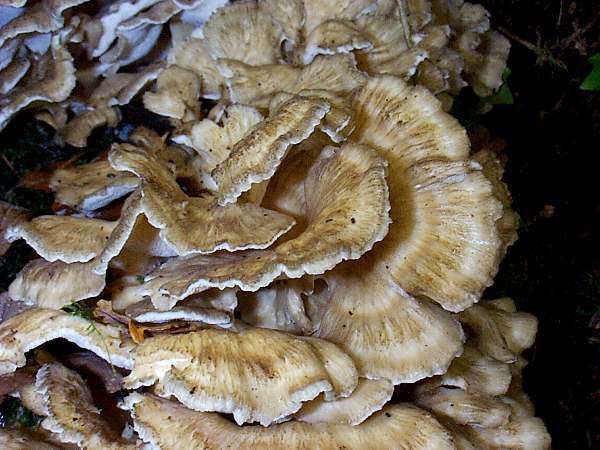
Culinary Notes
This large fungus is generally reported to be a very good edible species if gathered when young, but in common with other polypore fungi it becomes too tough and leathery to eat when it is fully mature.
In Japan this is a popular and highly-prized edible as well as reputedly having medicinal value including cancer-resisting properties. The Japanese call it Maitake, which means 'the dancing mushroom'. Rather than being scoured from the wild, fruitbodies are cultivated on impregnated logs made from compressed sawdust.
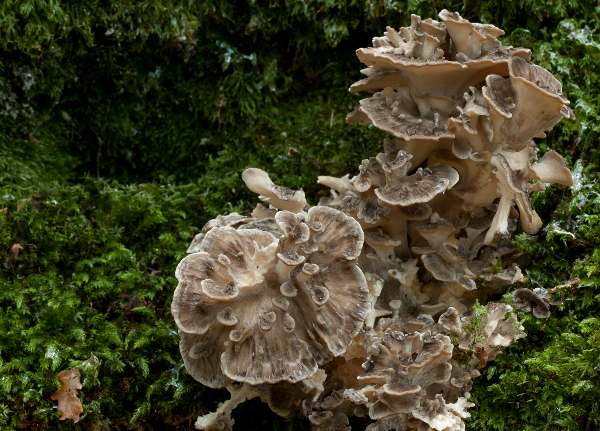
Reference Sources
Fascinated by Fungi, 2nd Edition, Pat O'Reilly 2016, reprinted by Coch-y-bonddu Books in 2022.
BMS List of English Names for Fungi
Dictionary of the Fungi; Paul M. Kirk, Paul F. Cannon, David W. Minter and J. A. Stalpers; CABI, 2008
Taxonomic history and synonym information on these pages is drawn from many sources but in particular from the British Mycological Society's GB Checklist of Fungi.
Acknowledgements
This page includes pictures kindly contributed by Rob Evans, David Kelly and Harold Seelig.
Fascinated by Fungi. Back by popular demand, Pat O'Reilly's best-selling 450-page hardback book is available now. The latest second edition was republished with a sparkling new cover design in September 2022 by Coch-y-Bonddu Books. Full details and copies are available from the publisher's online bookshop...
